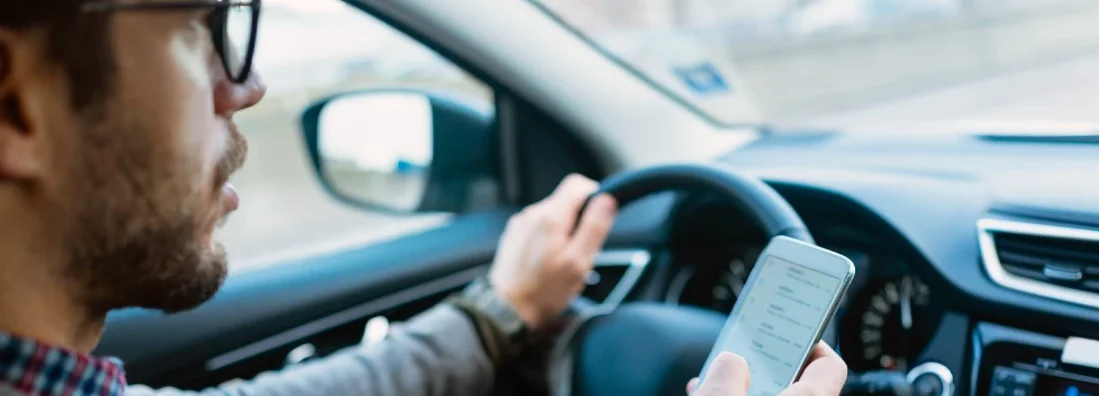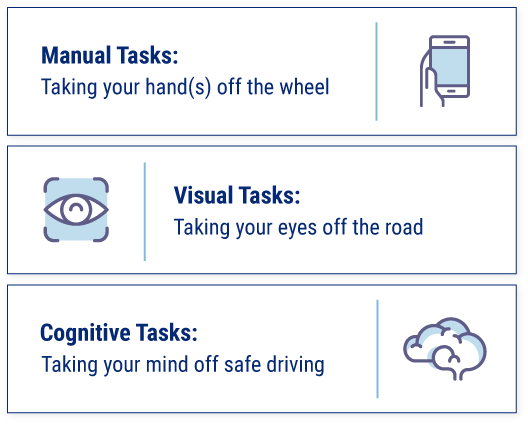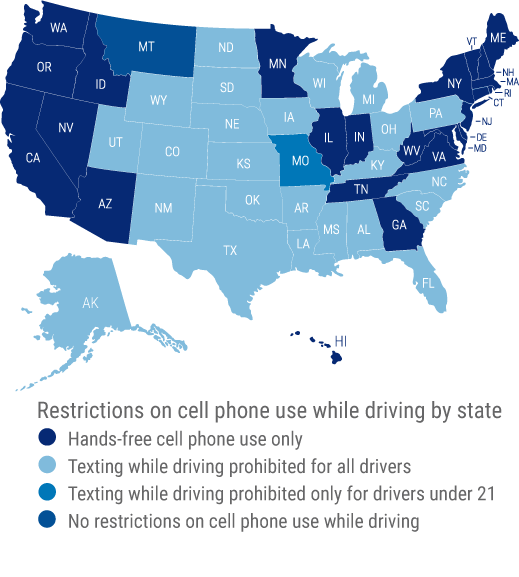Distracted Driving Laws
Knowing your state's distracted driving laws can help you avoid harsh fines and other penalties, and ultimately save lives in the process.

Jeff Green has held a variety of sales and management roles at life insurance companies, Wall street firms, and distribution organizations over his 40-year career. He was previously Finra 7,24,66 registered and held life insurance licenses in multiple states. He is a graduate of Stony Brook University.

No matter which roads you use, drivers across the country must understand the dangers and the laws surrounding distracted driving. It's also critical to understand how these rules change as you travel across the US. Though some states only charge fines for each offense, others can issue jail time or points on your license.
We'll walk you through some major factors you need to know about distracted driving laws in the US. You'll also want to get in touch with your independent insurance agent to double-check your car insurance policy. But for starters, here's a state-by-state guide to distracted driving laws.
What Qualifies as Distracted Driving?
Though texting and the use of cell phones tend to be the focus when thinking of distracted driving, the reality is that these factors only make up a small percentage of the problem. Texting can take your eyes off the road for an average of five seconds, and while traveling at 55 mph, that's the equivalent of traveling the length of a football field with your eyes closed.
Texting led to an alarming 3,142 deaths in 2020. But more attention needs to be paid to all types of distracted driving to better protect everyone on and around the road. Here are some of the main types:
Types of Driver Distractions:

- Manual distractions: These involve the driver taking their hands off the wheel. Examples include tuning the radio, eating or drinking, programming a GPS, and smoking.
- Visual distractions: These involve the driver taking their eyes off the road. Examples include looking at a map or GPS, looking for an item in the car, watching an accident or other activity on the side of the road, looking at a cell phone, or adjusting climate controls.
- Cognitive distractions: These involve the driver taking their mind or focus off the act of driving. Examples include daydreaming or thinking hard while driving, holding a conversation with passengers, driving while crying or enraged, or talking on the phone, even with a hands-free system.
Knowing how each of these activities can detract from your driving performance can help you make the road a safer place for yourself and others.
Which States Have Laws against Distracted Driving?
Currently, every state in the US has a law that prohibits some sort of cell phone usage except for Montana.
Compare your state to the rest of the US when it comes to texting and driving restrictions

The dark blue states on this map indicate laws that enforce hands-free cell phone use while driving only. The light blue states ban texting while driving for all drivers. In Missouri, texting while driving is only banned for drivers under the age of 21. In Montana, there are currently no restrictions on cell phone use while driving.
Distracted Driving Fines and Penalties across Each State
The fines for violating cell phone usage laws while driving vary by state. The most expensive fines in the US are in Alaska and Utah, while some of the least expensive are in Kentucky and South Carolina.
| State | Fine/Penalty |
| Alabama | Fine of $25 for the first offense, increased fines for subsequent offenses. Teenage drivers under the age of 18 will pay fines ranging between $150 and $350 for violating the law |
| Alaska | Fines of up to $500 |
| Arizona | Fines between $75 and $149 for the first offense, and $100 to $250 for repeat offenses |
| Arkansas | Fines of $250 for the first offense, $500 for the second offense |
| California | Fine of $162 for the first offense, and a fine of $285 for following offenses |
| Colorado | Fine of $50 for the first offense for minor drivers, Up to one-year imprisonment, $1,000 fine, or both for adult drivers |
| Connecticut | Fines of up to $150 for the first offense, increased fines for subsequent offenses |
| Delaware | Fine of $100 for the first offense, increased fines for subsequent offenses |
| District of Columbia | Fines ranging from $100 to $200 |
| Florida | Fine of $30 per offense, $60 for subsequent offenses |
| Georgia | Fine of $50 per offense, plus one point added to your driving record, and increasing fines and points for subsequent offenses |
| Hawaii | Fines of $250 for the first offense and $300 for subsequent offenses |
| Idaho | Fines of up to $75 plus court fees for the first offense, $150 fines for the second offense |
| Illinois | Fines of up to $75 for the first offense, $100 for the second offense |
| Indiana | Fines of up to $500 |
| Iowa | Fines of up to $100 plus court fees |
| Kansas | Fines of $60 plus court fees |
| Kentucky | Fines of $25 up to $50, and three points on your license for every offense |
| Louisiana | Fines of $500 for the first offense, and up to $1,000 plus a 60-day suspension for subsequent offenses |
| Maine | Fines of $250 for the first offense and $500 for subsequent offenses plus a minimum of 30-day license suspension for subsequent offenses |
| Maryland | Fines of up to $75 for the first offense plus court costs, and $125 plus court costs for subsequent offenses |
| Massachusetts | Fines of $100 for a first offense, $250 fine for a second offense, and $500 for a third and subsequent violations |
| Michigan | Fines of up to $100 for the first offense, $200 for the second offense |
| Minnesota | Fines of $50 for the first offense, up to $275 for the second offense |
| Mississippi | Fines of up to $100 |
| Missouri | Fines of up to $200 |
| Montana | N/A; there are no laws prohibiting cell phone use while driving in this state |
| Nebraska | Fines of between $200 and $500 and three points on your driver's license |
| Nevada | Fines starting at $50 for the first offense, $100 for the second offense, and $250 for the third and subsequent offenses |
| New Hampshire | Fine of $100 for the first offense, $250 for the second offense, and $500 for subsequent offenses within a two-year period |
| New Jersey | Fines of starting at $200 for the first offense, starting at $400 for the second offense, and starting at $600 for the third offense |
| New Mexico | Fines starting at $25, and $50 for every subsequent offense |
| New York | Fines for a first offense can be as high as $200, and subsequent offenses can be as high as $450 |
| North Carolina | Fine of $100 plus court costs |
| North Dakota | Fine of $100 |
| Ohio | Fine of $100, and can include a six-month suspension of your license |
| Oklahoma | Fines start at $100 and can include the suspension of your license |
| Oregon | Fines of up to $1,000 for the first offense, and up to $2,000 for the second offense |
| Pennsylvania | Fines start at $50 and associated court fees |
| Rhode Island | Fines from $100 up to $250 |
| South Carolina | Fines starting at $25 |
| South Dakota | Fine of $100 for each offense |
| Tennessee | Fine of $50 plus court fees for the first and second offense, $100 for the third and subsequent offenses |
| Texas | Fines of between $25 and $99 for the first offense, and up to $200 for subsequent offenses |
| Utah | Fines of $100 for the first offense, up to $750, possibly 3 months in jail, and a misdemeanor on the driving record for subsequent offenses |
| Vermont | Fines up to $200 for the first offense, and $250 to $500 for subsequent offenses |
| Virginia | Fines between $100 to $250 and two points on your license |
| Washington | Fines of $136 for the first offense, and $234 for the second offense |
| West Virginia | Fines of $100 for the first offense, $200 for the second offense, and $300 for subsequent offenses, plus 3 points on your license |
| Wisconsin | Fines from $20 to $400 |
| Wyoming | Fines up to $75 per offense |
Why Is Preventing Distracted Driving So Important?
Since car crashes are the number one killer of teens in the US, and up to 58% of crashes can be attributed to distracted driving, ending this issue is critical. Here are some more shocking distracted driving stats:
- Looking away from the road for just three seconds can cause a crash, and the average text message takes five seconds of your attention.
- Engaging in hazardous activities while driving, such as applying makeup, changing clothes, etc., has been admitted by more than 80% of drivers.
- Listening to a conversation or music can decrease a driver's attention by as much as 40%.
- Eating while driving can increase your risk of an accident by 80%.
- Getting into an accident is six times more likely while texting than while driving drunk.
- Though 94% of teenagers know that texting while driving is dangerous, 35% of them admit to doing it anyway.
- The FCC reports that at any given time during daylight hours, about 481,000 motorists are using their cell phones.
These eye-opening distracted driving stats can really put into perspective the importance of ending distracted driving behaviors once and for all.
Six Helpful Tips to Keep Yourself from Distracted Driving
Fortunately, there are some easy ways to keep yourself focused on the road. Follow these helpful tips below to stop yourself from distracted driving behaviors.
- Limit cell phone use while driving.
- Use an app to silence all of your phone's notifications while driving.
- Wait until after you're done driving to eat, schedule plans, find items in your car, etc.
- Only engage in light conversation with any passengers while driving, and always avoid emotional or upsetting topics while on the road.
- Ensure that children and pets are properly secured before you start driving.
- If you must adjust your car's controls, tend to a pet or child, or use your cell phone, pull over to a safe parking spot first.
These tips may sound simple, but following them can have a huge impact, from avoiding fines to saving lives.
What Kinds of Efforts Are Being Made to Stop Distracted Driving?
Since the problem of distracted driving is only getting bigger as time goes on, states create new laws every day to help limit the potential dangers. The US's main focus until now has been banning texting and cell phone use while driving, but more and more states are starting to allow hands-free cell phone usage. Other states, still, are implementing laws to ban eating and other activities while driving.
The US Department of Transportation has also created a website to provide safe driving tips for teen drivers and their parents. Insurance companies are also implementing programs to cut down on distracted teen driving, and many of them have started teen safety programs. Click on the state links above to get more information on measures your state is taking to curb distracted driving.
Can a Car Insurance Company Cancel Your Coverage if You Get a DUI or Other Driving Offense?
Each state has its own auto insurance cancellation regulations. According to insurance expert Jeffery Green, insurance companies can generally cancel an auto policy for any reason within the first 60 to 90 days as long as they provide notice and a reason.
After that time, the insurance company can only cancel the policy if there were material misrepresentations on the application, or if the insured’s license was suspended or revoked. An insurance company could cancel your policy if your DUI resulted in a suspended license.
Why Choose an Independent Insurance Agent?
Independent insurance agents simplify the process by shopping and comparing insurance quotes for you. Not only that, but they’ll also cut through the jargon and clarify the fine print so you'll know exactly what you’re getting.
Independent insurance agents also have access to multiple insurance companies, ultimately finding you the best car insurance coverage, accessibility, and competitive pricing while working for you.
https://www.drive-safely.net/delaware-distracted-driving-laws/
https://www.idrivesafely.com/defensive-driving/trending/texting-and-driving-laws-and-fines-state#:~:text=Missouri%20and%20Montana%20are%20the,have%20banned%20this%20driving%20hazard.
https://mpdc.dc.gov/page/distracted-driving-safety-act-2004-restrictions-mobile-phone-use-while-driving#:~:text=Get%20Involved!-,Distracted%20Driving%20Safety%20Act%20of%202004%3A%20restrictions%20on%20mobile%20phone,with%20a%20hands%2Dfree%20accessory.
https://handsfreeinfo.com/hawaii-cell-phone-laws-legislation/
https://leg.colorado.gov/content/distracted-driving-and-cell-phone-use
https://www.bpglegal.com/articles/texting-driving-iowas-new-law/
https://www.drivinglaws.org/resources/kansas-text-cell-phone-driving-laws.html#:~:text=Fines%20and%20suspensions%20for%20violations,and%20a%20maximum%20%24500%20fine.
https://getjerry.com/driving/texting-and-driving-in-kentucky
https://illinoiscarlaws.com/distracted-driving/
https://www.in.gov/dol/media/social-media/drive-now-txt-l8r-social-media-contest/distracted-driving/
https://www.americaninsuranceid.com/blog/2021/04/q-a-does-idaho-have-a-new-cell-phone-law#:~:text=APRIL%20IS%20DISTRACTED%20DRIVING%20MONTH&text=In%20Idaho%2C%20a%20first%20offense,insurance%20rates%20may%20be%20affected.
https://www.ldi.la.gov/docs/default-source/documents/publicaffairs/distracted-driving/facts-about-distracted-driving.pdf?sfvrsn=6a327552_6#:~:text=Operating%20a%20mobile%20device%20or,fine%20of%20up%20to%20%24500.
https://legislature.maine.gov/lawlibrary/what-is-maines-law-on-distracted-driving-text-messaging/9460#:~:text=29%2DA%20MRS%20%C2%A72119%20prescribes%20penalties%20for%20its%20violation,license%20suspension%20for%20repeat%20offenders.
https://mva.maryland.gov/safety/Pages/mhso/program-distracted-driving.aspx#:~:text=Maryland%20Laws%3A,%2440%20and%20subsequent%20offenses%20%24100.
https://www.mass.gov/service-details/hands-free-law#:~:text=Penalty%20for%20violating%20the%20hands,of%20distracted%20driving%20educational%20program.
https://www.michigan.gov/msp/divisions/ohsp/distracted-driving#:~:text=As%20of%20July%201%2C%202010,Subsequent%20offenses%20cost%20%24200.
https://www.house.leg.state.mn.us/hrd/pubs/ss/ssdistdrvg.pdf
https://www.heilmanlawgroup.com/mississippi/jackson/mississippis-texting-while-driving-laws/#:~:text=A%20texting%20while%20driving%20ticket,to%20a%20reckless%20driving%20conviction.
https://www.enjuris.com/ohio/car-accident/distracted-driving-accidents.html
https://www.knowleslawfirm.com/what-are-the-texting-and-driving-laws-in-nebraska/#:~:text=The%20fine%20for%20breaking%20Nebraska's,suspended%20or%20revoked%20driver's%20license.
https://www.jacksonlewis.com/resources-publication/new-nevada-law-bans-cell-phone-use-while-driving#:~:text=Fines%20and%20Penalties,the%20immediately%20preceding%20seven%20years.
https://www.manningzimmermanlaw.com/does-new-hampshires-2020-law-prohibit-talking-on-the-phone-while-driving/#:~:text=New%20Hampshire%20law%20imposes%20these,subsequent%20violation%20within%20two%20years
https://nj.gov/mvc/justdrive/
https://www.michaeljdoylelaw.com/legal-blog/2021/april/texting-and-driving-law-in-new-mexico-what-you-n/#:~:text=Secondary%20offenses%20can%20be%20cited,fine%20is%20raised%20to%20%2450.
https://trafficticketsny.com/distracted-driving-tickets/
https://www.twifordlaw.com/criminal-defense/2020/07/15/can-you-use-a-cell-phone-while-driving-north-carolina-distracted-driving-laws/#:~:text=A%20%24100%20fine%20plus%20court,not%20assessed%20for%20a%20conviction.
https://www.dot.nd.gov/divisions/safety/streetskills/distracteddriving.htm
https://www.edwardspattersonlaw.com/blog/oklahoma-distracted-driving-laws/#:~:text=What%20Are%20the%20Penalties%20for,subject%20to%20the%20emergency%20exception).
https://www.oregon.gov/odot/safety/pages/distracted.aspx#:~:text=A%20first%20offense%20that%20doesn,a%20maximum%20fine%20of%20%242%2C000.
https://www.penndot.pa.gov/TravelInPA/Safety/TrafficSafetyAndDriverTopics/Documents/Texting-Ban-Fact-Sheet.pdf
https://www.dot.ri.gov/projects/HandsFree/index.php
https://www.hg.org/legal-articles/south-carolina-s-distracted-driving-laws-50281
https://www.northernplainsjustice.com/blog/south-dakotas-distracted-driving-law-now-in-effect.cfm#:~:text=Now%2C%20under%20House%20Bill%201169,purposes%20or%20to%20call%20911
https://www.drivinglaws.org/resources/wyoming-text-cell-phone-laws.html
https://www.pattonandpittman.com/blog/2021/february/is-distracted-driving-a-criminal-offense-in-tenn/#:~:text=Distracted%20Driving%20in%20Tennessee%20is,zones%20or%20school%20zones%2C%20%24200
https://www.hg.org/legal-articles/distracted-driving-laws-in-texas-what-you-need-to-know-50633
https://siegfriedandjensen.com/blog/what-you-need-to-know-about-texting-and-driving-in-utah/#:~:text=According%20to%20Utah's%20laws%2C%20anyone,a%20misdemeanor%20on%20their%20record.
https://www.vpr.org/vpr-news/2014-01-30/what-are-vermonts-distracted-driving-laws-anyway
https://ladenburglaw.com/distracted-driving-laws-in-washington/
https://transportation.wv.gov/communications/PressRelease/Pages/The-West-Virginia-Governor%E2%80%99s-Highway-Safety-Program-reminds-drivers-Using-your-cell-phone-while-driving-is-illegal.aspx#:~:text=The%20fine%20for%20the%20first,of%20%24200%20and%20court%20costs.
https://www.bucherlawgroup.com/milwaukee-county-lawyer/what-are-the-penalties-for-distracted-driving-in-wisconsin
https://www.nhtsa.gov/risky-driving/distracted-driving
